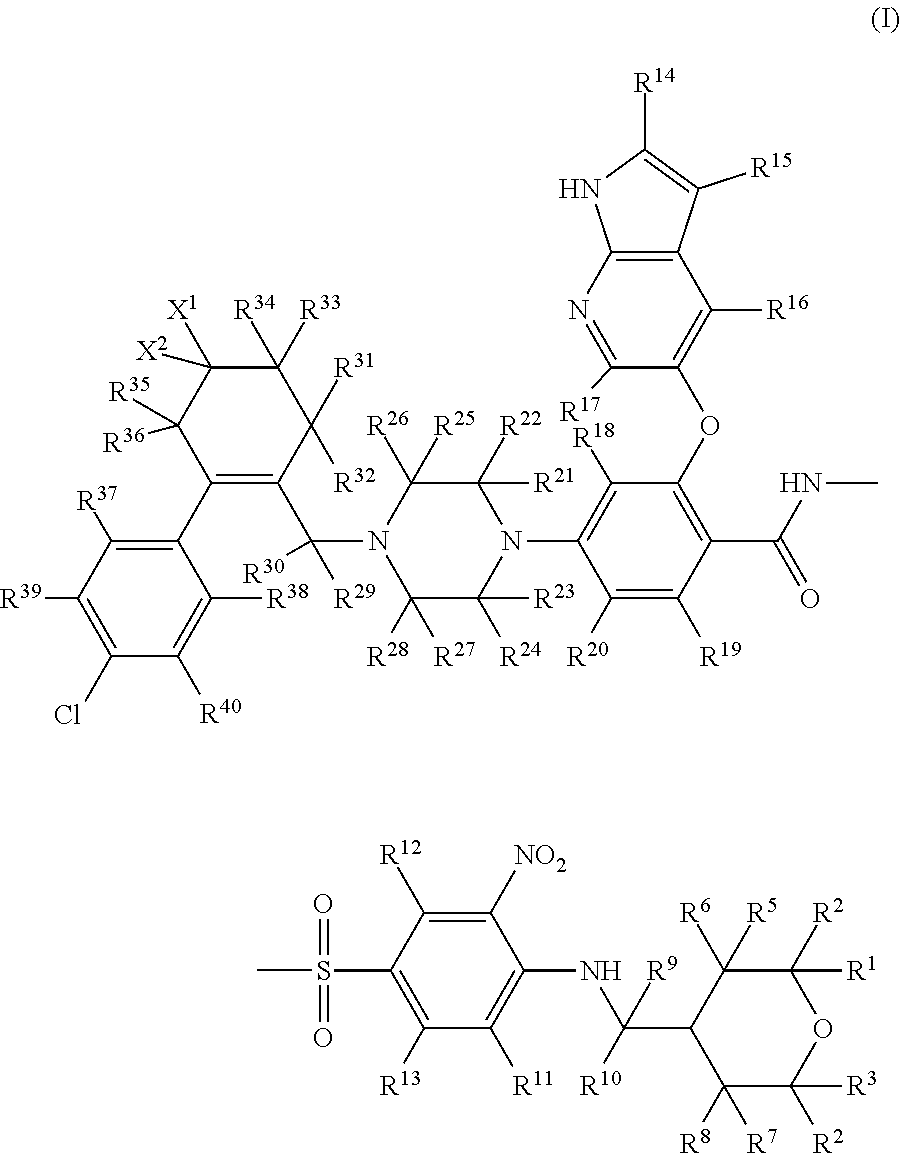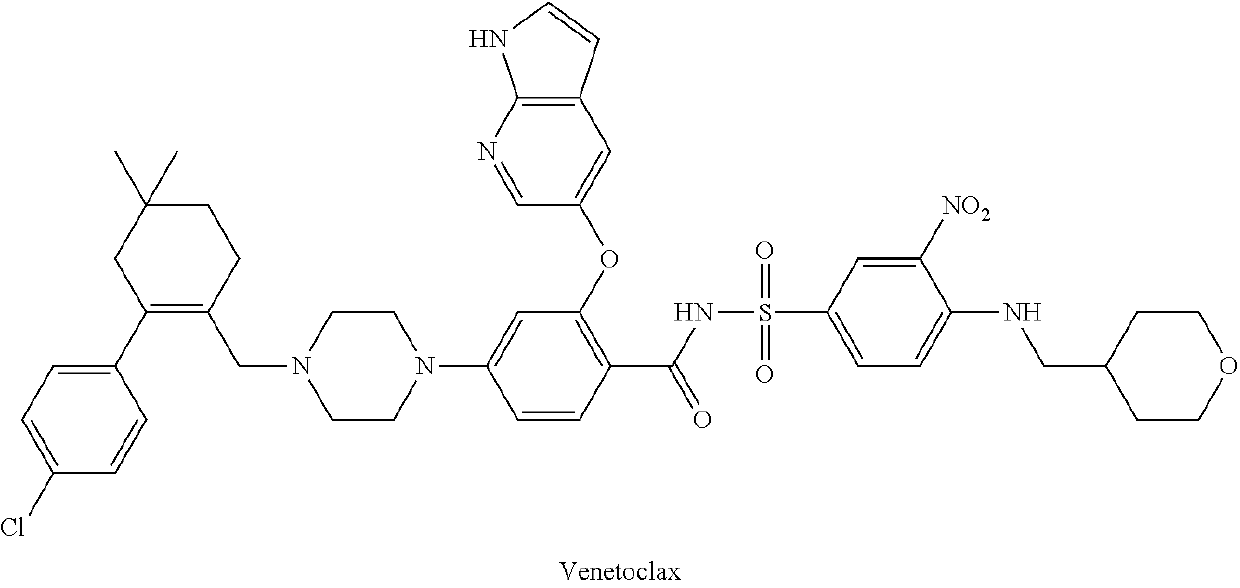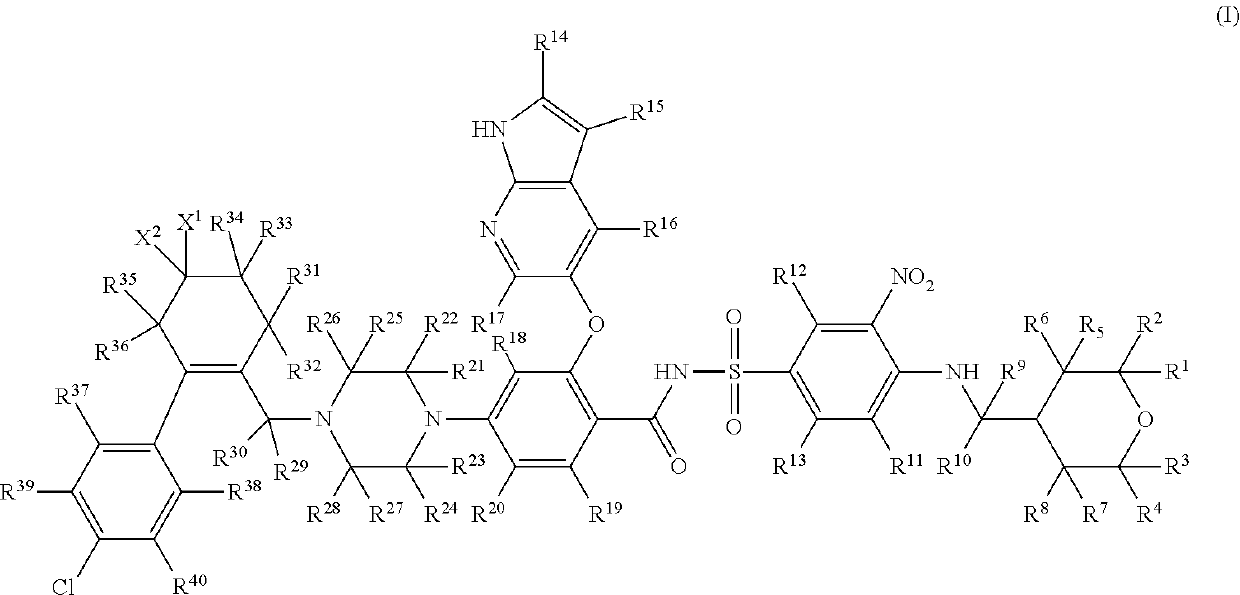Benzenesulfonylbenazamide compound for inhibiting bcl-2 protein and composition and use thereof
a technology of benzenesulfonylbenzamide and compound, which is applied in the field of nbenzenesulfonylbenzamide compounds, can solve the problems of adverse reactions such as neutropenia, diarrhea, nausea, and the approval of bcl-2 protein inhibitors, and achieves improved applicability, excellent inhibitory properties, and better pharmacokinetic parameters
- Summary
- Abstract
- Description
- Claims
- Application Information
AI Technical Summary
Benefits of technology
Problems solved by technology
Method used
Image
Examples
example 1
Preparation of 4-(4-{[2-(4-chlorophenyl)-4,4-dimethylcyclohex-1-en-1-yl]methyl-d2}piperazin-1-yl)-N-({3-nitro-4-[(tetrahydro-2H-pyran-4-ylmethyl)amino]phenyl}sulfonyl)-2-(1H-pyrrolo[2,3-b]pyridin-5-yloxy)benzamide, which is compound T-1, Represented by the Following Formula
[0107]
[0108]The following routes is used for synthesis:
Step 1 Synthesis of Compound 5
[0109]Under the protection of nitrogen, sodium hydride (1.9 g, 79.3 mmol) and dimethyl carbonate (14.3 g, 158.6 mmol) were added to anhydrous THF (15 ml) and heated. A solution of 3,3-dimethylcyclohexan-1-one (5.0 g, 39.6 mmol) in THF was added dropwise while refluxing, and the refluxing was continued for 4 h after the addition. The mixture was cooled to room temperature and the reaction was quenched by the addition of methanol. Water and dichloromethane were added for extraction, and the organic phase was collected and purified by column chromatography to give 4.2 g of a colorless liquid product, with the yield of 70%.
Step 2 Synt...
example 2
Preparation of 4-(4-{[2-(4-chlorophenyl)-4,4-dimethylcyclohex-1-en-1-yl]methyl-d2}piperazin-1-yl)-N-({3-nitro-4-[(tetrahydro-2H-pyran-4-ylmethyl-d2)amino]phenyl}sulfonyl)-2-(1H-pyrrolo[2,3-b]pyridin-5-yloxy)benzamide, which is compound T-2, Represented by the Following Formula
[0119]
[0120]The following routes is used for synthesis:
Step 1 Synthesis of Compound 15
[0121]Under the condition of 0° C., LiAlD4 (0.4 g, 10.08 mmol) was added dropwise to a solution of compound 14 (1.0 g, 9.00 mmol) in tetrahydrofuran (20 ml) slowly, after which the reaction was continued for 1 h. 1 M of hydrochloric acid (10 ml) was added to quench the reaction, and the resulting mixture was extracted with dichloromethane (40 ml×3). The organic phases were combined and dried over anhydrous sodium sulfate. The solvent was removed to give 0.72 g of a light yellow solid, with the yield of 68.6%. LC-MS(APCI): m / z=118.29 (M+1)+.
Step 2 Synthesis of Compound 16
[0122]4-Fluoro-3-nitrobenzenesulfonamide (1.12 g, 5.12 mm...
example 3
Preparation of 4-(4-{[2-(4-chlorophenyl)-4,4-dimethylcyclohex-1-en-1-yl]methyl}piperazin-1-yl)-N-({3-nitro-4-[(tetrahydro-2H-pyran-4-ylmethyl-d2)amino]phenyl}sulfonyl)-2-(1H-pyrrolo[2,3-b]pyridin-5-yloxy)benzamide, which is compound T-3, Represented by the Following Formula
[0124]
[0125]The following routes is used for synthesis:
Step 1 Synthesis of Compound 17
[0126]Under the condition of 0° C., LiAlH4 (0.14 g, 3.59 mmol) was added dropwise to a solution of compound 7 (1.0 g, 3.59 mmol) in tetrahydrofuran (20 ml) slowly, after which the reaction was continued for 1 h. 1 M of hydrochloric acid (10 ml) was added to quench the reaction, and the resulting mixture was extracted with dichloromethane (40 ml×3). The organic phases were combined and dried over anhydrous sodium sulfate. The solvent was removed to give 0.8 g of a light yellow liquid product, with the yield of 89%.
Step 2 Synthesis of Compound 18
[0127]Compound 17 (0.8 g, 3.19 mmol) was added to a mixture of acetonitrile (15 ml) and...
PUM
| Property | Measurement | Unit |
|---|---|---|
| Molar density | aaaaa | aaaaa |
| Molar density | aaaaa | aaaaa |
| Molar density | aaaaa | aaaaa |
Abstract
Description
Claims
Application Information
 Login to View More
Login to View More - R&D
- Intellectual Property
- Life Sciences
- Materials
- Tech Scout
- Unparalleled Data Quality
- Higher Quality Content
- 60% Fewer Hallucinations
Browse by: Latest US Patents, China's latest patents, Technical Efficacy Thesaurus, Application Domain, Technology Topic, Popular Technical Reports.
© 2025 PatSnap. All rights reserved.Legal|Privacy policy|Modern Slavery Act Transparency Statement|Sitemap|About US| Contact US: help@patsnap.com



